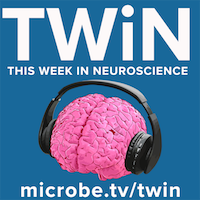Junjie from Jason’s lab joins TWiN to discuss the observation that the cell gene PNMA2 encodes non-enveloped virus-like capsids that induce autoantibodies which underlie paraneoplastic syndrome.
TWiN explains the finding that immunity to commensal bacteria promotes sensory neuron regeneration via the cytokine interleukin-17A.
TWiN reviews the field of microgial research, which has advanced in recent decades but is constrained by nomenclature that is necessary but often implies specific functions. Hosts: Vincent Racaniello, Jason Shepherd, Timothy Cheung, and Vivianne…
TWiN answers listener questions about Alzheimer’s disease, glaucoma and the microbiota, Dravet’s Syndrome, schizophrenia, brain development, and chips implanted in the human brain.
Jason and Tim review the use of an implanted chronic deep brain sensing and stimulation device to carry out biomarker-driven closed-loop therapy that resulted in a rapid and sustained improvement in depression.
TWiN explains how central nervous system resident macrophages known as microglia coordinate cellular interactions during spinal cord repair in mice.
TWiN describes how neurotropic viruses leave the brain via meningeal lymphatic vessels located dorsally and basally beneath the skull.
TWiN reviews how, in a mouse stroke model, recovery of movement is associated with the remaining cortex and the striatum coordinating their activity together.
TWiN explains the observation that in mice, the HIV-1 co-receptor CCR5 closes the temporal window for linking different memories.
TWiN describes experiments demonstrating that gut injection of alpha-synuclein fibrils in mice converts endogenous alpha-synuclein to a pathologic form that spreads to the brain and leads to features of Parkinson’s disease.

